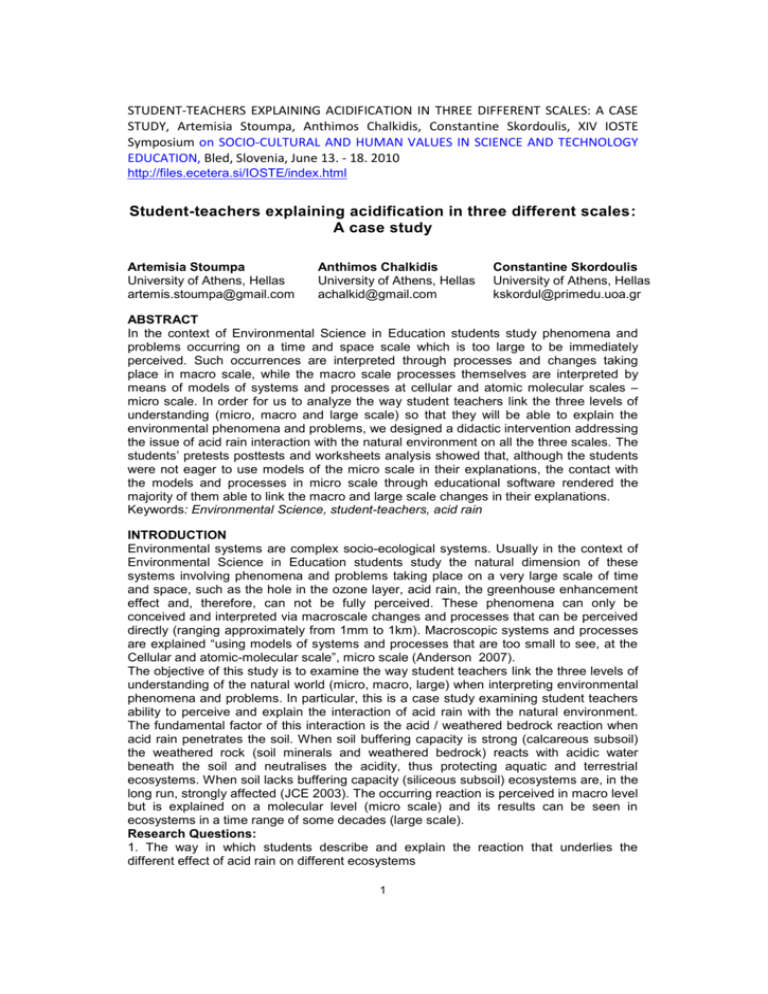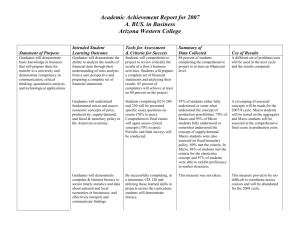stoumpa-2010
advertisement

STUDENT-TEACHERS EXPLAINING ACIDIFICATION IN THREE DIFFERENT SCALES: A CASE STUDY, Artemisia Stoumpa, Anthimos Chalkidis, Constantine Skordoulis, XIV IOSTE Symposium on SOCIO-CULTURAL AND HUMAN VALUES IN SCIENCE AND TECHNOLOGY EDUCATION, Bled, Slovenia, June 13. - 18. 2010 http://files.ecetera.si/IOSTE/index.html Student-teachers explaining acidification in three different scales: A case study Artemisia Stoumpa University of Athens, Hellas artemis.stoumpa@gmail.com Anthimos Chalkidis University of Athens, Hellas achalkid@gmail.com Constantine Skordoulis University of Athens, Hellas kskordul@primedu.uoa.gr ABSTRACT In the context of Environmental Science in Education students study phenomena and problems occurring on a time and space scale which is too large to be immediately perceived. Such occurrences are interpreted through processes and changes taking place in macro scale, while the macro scale processes themselves are interpreted by means of models of systems and processes at cellular and atomic molecular scales – micro scale. In order for us to analyze the way student teachers link the three levels of understanding (micro, macro and large scale) so that they will be able to explain the environmental phenomena and problems, we designed a didactic intervention addressing the issue of acid rain interaction with the natural environment on all the three scales. The students’ pretests posttests and worksheets analysis showed that, although the students were not eager to use models of the micro scale in their explanations, the contact with the models and processes in micro scale through educational software rendered the majority of them able to link the macro and large scale changes in their explanations. Keywords: Environmental Science, student-teachers, acid rain INTRODUCTION Environmental systems are complex socio-ecological systems. Usually in the context of Environmental Science in Education students study the natural dimension of these systems involving phenomena and problems taking place on a very large scale of time and space, such as the hole in the ozone layer, acid rain, the greenhouse enhancement effect and, therefore, can not be fully perceived. These phenomena can only be conceived and interpreted via macroscale changes and processes that can be perceived directly (ranging approximately from 1mm to 1km). Μacroscopic systems and processes are explained “using models of systems and processes that are too small to see, at the Cellular and atomic-molecular scale”, micro scale (Αnderson 2007). The objective of this study is to examine the way student teachers link the three levels of understanding of the natural world (micro, macro, large) when interpreting environmental phenomena and problems. In particular, this is a case study examining student teachers ability to perceive and explain the interaction of acid rain with the natural environment. The fundamental factor of this interaction is the acid / weathered bedrock reaction when acid rain penetrates the soil. When soil buffering capacity is strong (calcareous subsoil) the weathered rock (soil minerals and weathered bedrock) reacts with acidic water beneath the soil and neutralises the acidity, thus protecting aquatic and terrestrial ecosystems. When soil lacks buffering capacity (siliceous subsoil) ecosystems are, in the long run, strongly affected (JCE 2003). The occurring reaction is perceived in macro level but is explained on a molecular level (micro scale) and its results can be seen in ecosystems in a time range of some decades (large scale). Research Questions: 1. The way in which students describe and explain the reaction that underlies the different effect of acid rain on different ecosystems 1 2. Which scales are used by the students when they describe and explain the acid rain effect on the natural environment 3. The way in which the students’ contact with models and processes of micro scale influences their ability to explain the phenomenon in macro and large scale. METHODOLOGY 59 pre-service teachers, students of the National and Kapodistrian University of Athens who attended the one-semester course “Natural and Environmental Sciences – a Laboratory approach” in 2008-2009, explored the effect of acid rain on the natural environment. Initially, students investigated how different underlying bedrocks influence acid rain interaction with the natural environment in the wet lab (macro scale approach). Afterwards they approached this very issue in large scale using educational software. Finally, through the same educational software, they examined how micro scale processes explain the different effect of acid rain on ecosystems that, although similar at first sight, are founded on different subsoil. In the three stages of our didactic intervention, students filled in worksheets, while they completed pre and post tests both before and after the intervention. These worksheets and tests were collected and analyzed in order to answer the research questions. In order to analyze our data (students answers), we perched on a similar study of Solsona et al(2003) where senior high school students were categorized according to the way they described the concept of chemical change, a concept that is interpreted in two scales (micro and macro) in school science. The initial (Solsona’s and her colleagues’) categories were modified and expanded so that our data could be displayed more precisely, and the large scale which is absent from traditional Chemistry curriculum but is crucial in Environmental Science in Education could be included. RESULTS AND CONCLUSIONS In the pretests students preferred to give macro-scale descriptions. The majority of them knew about acid rain interaction with calcareous rocks, but this knowledge was rather superficial – they didn’t comprehend what this chemical interaction meant. So, they deduced that ecosystems resting on calcareous foundation were more vulnerable to acid rain attack. In the wet lab they tried different rock types interaction with acidic solutions and they confirmed their initial notion about the strong acid / calcareous stone reaction. Although the vast majority of them measured the pH increase this interaction entailed, they persisted focusing on the destructive side of the reaction. Consequently, they linked micro and large scales suggesting that this interaction led to physical environment erosion (which is wrong). However, a small part of the sample (9 subjects) begun to suspect the impact the pH change might have on ecosystems. When, through the software, students approached the problem in the large scale domain (ecosystems long term alteration), they described it in this scale, and a remarkable part of the sample (20 subjects) were able to interpret the large scale phenomena (different acid rain effects on, at first sight, similar ecosystems) by macro scale processes, more specifically the acid /stone interaction as acidic water percolates the soil. They described this interaction as a change in properties - mainly in acidity. When students encountered micro scale systems and models through the software they seemed to fully comprehend the chemical reaction and its significance to the ecosystem. Approximately one quarter of the sample described the reaction accurately as being a process of disappearance of some substances (the strong acid being among them) and a formation of new ones with different properties. A larger part described the reaction as a change in properties (mainly in acidity) without clearly defining this reaction. These two parts of our sample successfully explained what occurred in large scale through macro scale processes. However, only a small part of the sample (approximately 1/10), made links among the three scales (micro macro and large). Thus, it was difficult for the majority of the students to use micro scale systems, models and processes in their explanations. Their interaction with the micro scale world helped 2 them to enhance their understanding of the chemical reaction, and this, therefore, enabled them to associate macro scale processes with large scale phenomena. REFERENCES Anderson C.W.(2007). Environmental Literacy Learning Progressions, available at: http://www.project2061.org/publications/2061connections/2007/media/KSIdocs/anderson_paper.pd f (last accessed 21-10-2009) JCE (2003). JCE Classroom Activity: #50 Acid Raindrops Keep Fallin’ in My Lake Journal of Chemical Education, 80 (1) Solsona, Nu&acute'ria, Izquierdo, Merce' and de Jong, Onno(2003)'Exploring the development of students' conceptual profiles of chemical change',International Journal of Science Education,25:1,3 — 12 3







